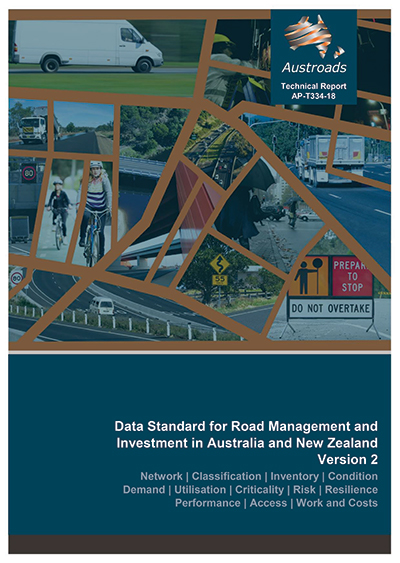Asset Management

- Publication no: AP-T334-18
- ISBN: 978-1-925671-62-9
- Published: 19 June 2018
- PDF (free) Download
The Data Standard for Road Management and Investment provides road agencies and their suppliers, in Australia and New Zealand, with a specification for the data that supports common operational activities.
The Data Standard also provides road network funding agencies with a specification to inform structure of reports and submissions requested from road agencies, to enable more equitable evidence-based investment decision making. Specifically, the Standard establishes a common understanding of the meaning or semantics of the data, to ensure appropriate use and interpretation of the data by its stakeholders.
The Standard also recognises various levels of sophistication in inventory and asset planning practice and provides relevant data item details in this regard. Accordingly, the Standard will benefit any road industry stakeholder who utilises data for road research, policy development, expenditure comparisons, funding approvals, supporting national reforms, national reporting, innovation, shared services, and inter-organisation communications.
This version of the Standard was superseded by Edition 3.0 released in January 2019.
- Summary
- 1. Overview
- 1.1 Purpose
- 1.2 Data Scope
- 1.3 Data Standard Context
- 1.4 Benefits and Impacts
- 1.5 Reporting Data in terms of this Standard
- 1.6 Prioritised Harmonised Set
- 2. Road Management and Investment Practice
- 3. Function Groups and Data Items
- 3.1 Data Specification Structure
- 3.2 Function Groups
- 3.2.1 Function Group Scope
- 3.2.2 Asset Lifecycle and Function Groups
- 3.2.3 Function Group Relationships
- 4. Setting the Context
- 4.1 Using This Standard
- 4.2 Road Network Definition
- 4.2.1 Road Network Topology
- 4.2.2 Link Sections
- 4.2.3 Relative Lengths
- 4.3 Location Referencing System
- 4.4 Asset Planning
- 4.5 Asset Data
- 4.6 Data Schemas
- 4.6.1 Function Groups
- 4.6.2 Data Items
- 4.6.3 Asset Management and Investment Activities
- 4.6.4 Logical Navigation to Data Specifications
- 4.7 Determining the Appropriate Levels of Sophistication
- Using the Sophistication Guide
- 5. Asset Data Life Cycle
- 6. Data Classes
- 6.1 Data Class Definition
- 6.2 Data Class Attributes (Data Item)
- 7. Data Item Specifications (Common Classes)
- 7.1 Object Locations
- 7.1.1 Points
- 7.1.2 Polylines
- 7.1.3 Polygons
- 7.2 Data Control
- 7.1 Object Locations
- 8. Data Specifications (Data Classes)
- 8.1 Network Definition
- 8.2 Classification
- 8.3 Inventory
- 8.3.1 Amenities
- 8.3.2 Bins
- 8.3.3 Bridge / Major Culvert
- 8.3.4 Culverts (Minor)
- 8.3.5 Fences
- 8.3.6 ITS Assets
- 8.3.7 Kerb and Channel
- 8.3.8 Landscaping
- 8.3.9 Lighting
- 8.3.10 Line-Marking Assets
- 8.3.11 Mechanical and Electrical Assets
- 8.3.12 Parking
- 8.3.13 Pathways
- 8.3.14 Pavement
- 8.3.15 Pavement Surfacing
- 8.3.16 Pits
- 8.3.17 Poles
- 8.3.18 Public Art
- 8.3.19 Public Toilets
- 8.3.20 Retaining Walls
- 8.3.21 Road Barriers
- 8.3.22 Shelters
- 8.3.23 Signs
- 8.3.24 Slopes
- 8.3.25 Structures
- 8.3.26 Table Drains
- 8.3.27 Tactile Paving
- 8.3.28 Traffic Management Devices
- 8.3.29 Traffic Signals
- 8.3.30 Trees
- 8.3.31 Tunnels
- 8.3.32 Vehicle Crossings
- 8.4 Condition
- 8.5 Demand
- 8.6 Utilisation
- 8.7 Criticality
- 8.8 Risk
- 8.9 Resilience
- 8.10 Performance (Asset)
- 8.11 Performance (Financial)
- 8.12 Performance (Service)
- 8.13 Access
- 8.14 Works and Costs
- 9. Referenced Code Lists
- 10. Glossary of Terms and Definitions
- References
- Appendix A Example Network Reporting Measures
- Appendix B Data Items Listing
- Appendix C Activities Listing
